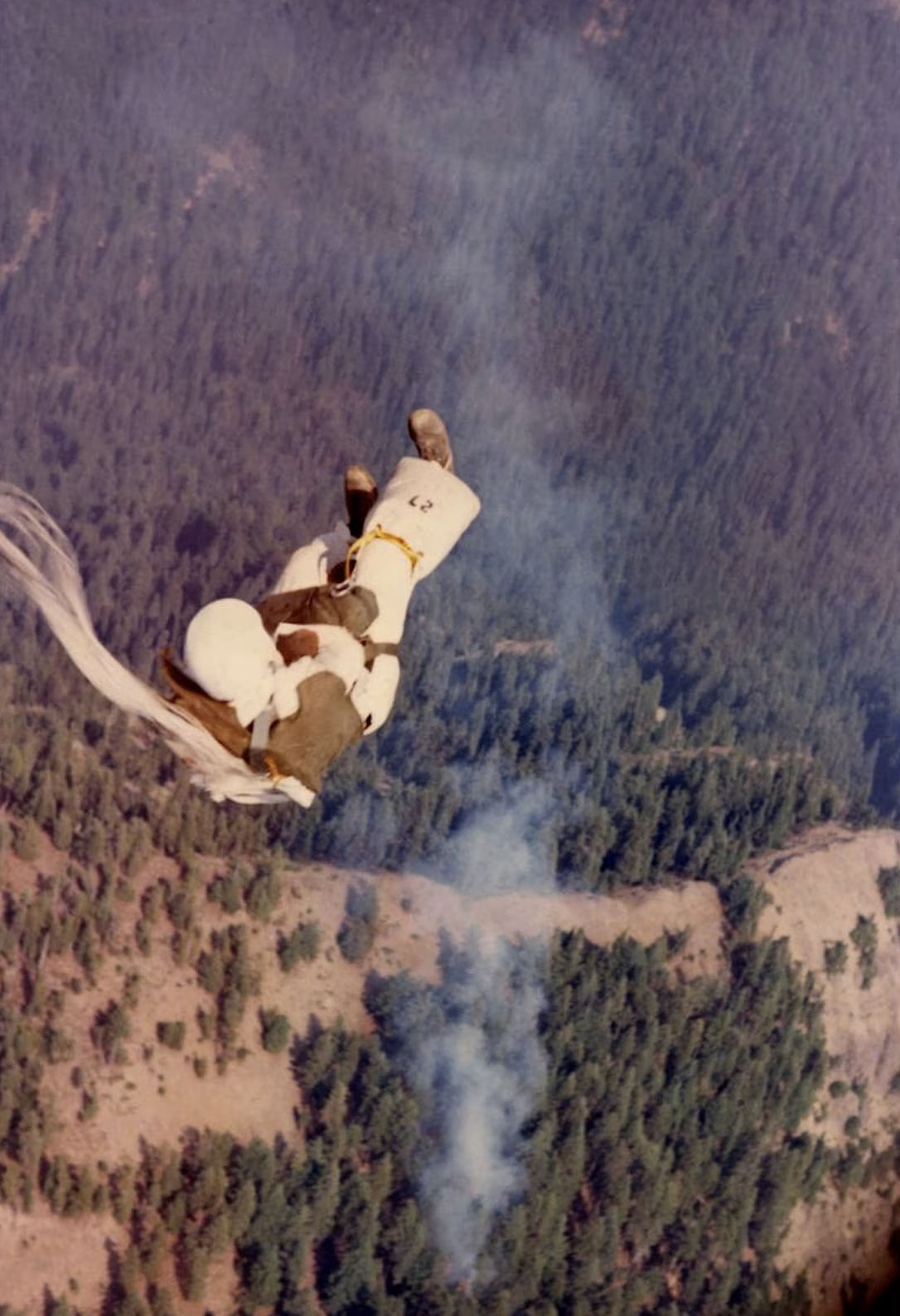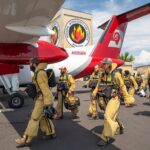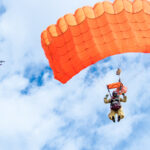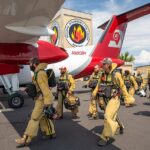
By Janet Eastman | The Oregonian/OregonLive
Retired smokejumper Gary Buck stopped parachuting out of airplanes into forest fires decades ago, but his devotion to his first career, launched at the Siskiyou Smokejumper Base near southwest Oregon’s Cave Junction, has never cooled.
Most days, Buck is at the unassuming, yet legendary former base, which is now the most authentic World War II-era smokejumper museum in the country, according to historians.
The rustic buildings, filled with handmade gear and fronted by two, 1940s Beechcraft jumper planes on the runway, represent the earliest days of strategic aerial wildfire suppression.
The volunteer-run Siskiyou Smokejumper Museum is officially open March 15 through Nov. 15 each year. But Buck, who lives nearby, has his phone number on museum signs, and welcomes people who pass by on Oregon Highway 199 to turn onto Smokejumper Way and call him.
“The tour is 30 minutes,” said Buck, “but we could talk for hours.”

Admission and tours are free, and the nonprofit museum welcomes donations.
The U.S. Forest Service’s first smokejumper bases were built in 1943 in Idaho and Oregon to rapidly place specially trained firefighters into a remote zone. After their initial attack and ground crews arrived, smokejumpers would carry out their gear, which weighed more than 120 pounds, for miles to the pick-up location.
Experts say the Siskiyou smokejumpers had the most difficult jump zones because of harsh country, steep land and towering trees.
Yet, collectively the Siskiyou crew made a total of 5,390 fire jumps, until the based closed after the 1981 fire season.
“We covered eight forests directly and others all over the West Coast, Canada, Alaska and Appalachia,” said Buck, whose starting pay in 1966 was $2.20 an hour. “This base was an extremely efficient government operation.”
Siskiyou crew’s legacy
Jack Heintzelman of the U.S. Forest Service, who established the Siskiyou Smokejumper Base 80 years ago, called smokejumpers “smokechasers with a faster means of travel.”
Quickly, the Siskiyou staff became models of the fledgling profession along the Pacific Coast, according to historians who nominated the base to be on the National Register of Historic Places. In 1957, the Siskiyou crew helped set up the Redding Smokejumper Base in northern California.
Smokejumpers, along with frontline hotshots and other wildland fire crews, remain an integral part of modern firefighting.
The Bureau of Land Management employs smokejumpers at bases in Boise, Idaho, and Fairbanks, Alaska. The U.S. Forest Service has about 320 smokejumpers at seven bases, from Idaho and Montana, to California and Washington.
Brian Janes, a 44-year-old smokejumper at Redding, has visited the Siskiyou Smokejumper Museum three times to talk to retired crew members, who fought fires in the 1950s and 1960s, about what has changed and what has stayed the same.
“They were pretty tough,” said Janes, who lives in Ashland and trained — “rookied” — in 2014.
“They had one radio, maybe, and fewer roads, making early smokejumpers’ pack outs from a fire four times longer, or more, than the 10 mile average now,” Janes said.
The biggest difference: Decades ago, the goal was to suppress a small wildfire before it spread. Today, a fire could be suppressed or monitored as it is being managed for resource benefits, said Josh Cantrell of the U.S. Forest Service’s Redmond Smokejumper Base.
“More and more, the fires we face are in closer proximity to communities as people push farther into the wildland-urban interface,” said Cantrell. “The longer, more intense fire seasons also require increased time allotted for training to safely operate in an increasingly complex fire environment.”
What hasn’t changed: Smokejumpers make, customize and repair their jumpsuit, harness, gear bags — everything but the parachute — at their base. Since the earliest years, they were taught to sew to repair and adjust their gear, and innovate to solve a problem, Janes said.
Tour guides at the Cave Junction museum, most often retired smokejumpers like Buck, take people into the 1948 parachute loft, the oldest one in the U.S., where the crew inspected parachutes and jump lines suspended from the high ceiling.
The rest of the building holds pieces of history, from color-coded signal streamers to a triangle-shaped table used to repair silk, later nylon parachutes. Inside other buildings are handwritten record books, rotary phones, a dispatch radio and other items frozen in time.
Firefighting groups across the country donate irreplaceable equipment, like century-old sewing machines, to the Siskiyou museum for safekeeping.
“Everyone knows the Siskiyou base,” said Janes. “Everyone in Redding talks about our home starting in Cave Junction, and every year we celebrate our anniversary.”
Superhero smokejumpers
:quality(70)/cloudfront-us-east-1.images.arcpublishing.com/advancelocal/2VOBS5VNJZACNLUT52V3LCPFKY.jpg)
Writers, filmmakers, photographers and others have romanticized smokejumpers as the superheroes of back-country firefighting.
When called, they drop fearlessly from the sky, apply fire science and physical strength to battle one of the most powerful forces on the planet, then emerge from the smoke, triumphantly, like an Indiana Jones-style James Bond.
Highly trained smokejumpers created a “glamorous” public image for the forest service a year before the fictional fire prevention spokesman Smokey Bear made his debut in 1944.
In many ways, smokejumpers have earned adoration.
In addition to firefighting and prescribed fire support, smokejumpers have assisted in the pandemic response, hurricane relief incidents, Space Shuttle Columbia recovery and other situations in which people are at risk, said Cantrell, Redmond Smokejumper Base manager.
The Redmond smokejumpers, frontline hotshots and other wildland fire crews are trained at the Redmond Air Center, which also offers free tours of the facility (call to reserve a limited place on a tour at 541-504-7200).
On the walls of the former Siskiyou Smokejumper Base headquarters, now the museum gallery, are crew portraits, one for each of the 39 fire seasons the base operated.
Many of the crew are legendary for parlaying smokejumping skills into other careers. Stuart Roosa became an astronaut on Apollo 14. Others also worked for NASA as well as federal intelligence agencies.
In 1971, a handful of the Cave Junction crew was interrogated by FBI agents searching for the skyjacker known as D.B. Cooper, who parachuted out of a Boeing 727 over southwestern Washington with a $200,000 ransom. The FBI found no evidence that the fugitive was a smokejumper.
Many smokejumpers were hired by Air America, a covert CIA airline that dropped cargo in Southeast Asia during the Vietnam War.
Lee Gossett, who grew up in the Rogue Valley, worked for Air America starting in 1964. Seven years before that, he was a teenage pilot who earned money for college by working as a Cave Junction smokejumper during summers.
“It was a big world out there and we all wanted our piece of it,” said Gossett, who lives in Central Point and contributes to the smokejumper museum. “Now I’m 84 and I see this was the starting point for my life.”
In his memoir, “Smokejumper to Global Pilot: A True Odyssey,” Gossett said he has benefited from his smokejumper training, which required parachuting, firefighting and woodsmanship skills as well as being in top physical condition.
Oregon author Paul Fattig’s new book, “The Mouse that Soared: Tales of the Siskiyou Smokejumpers,” is full of fascinating true stories of the Cave Junction crew, including Allen Owen, a 4-foot-11-inch smokejumper, better known by his nickname “Mouse.”
Owen’s success, even though he didn’t meet the height and weight requirements, opened doors for women to become smokejumpers, Fattig found after interviewing Deanne Shulman, the first woman smokejumper.
For his 442-page book, Fattig interviewed dozens of pioneering smokejumpers and historians. One chapter explains the secret mission conducted in Oregon by the famous 555th Parachute Infantry Battalion, an all-Black paratrooper unit of the U.S. Army, formed on Dec. 30, 1943 in Fort Benning, Georgia.
In 1945, the battalion was deployed to Pendleton, Oregon, and trained as smokejumpers. They became part of a large civilian and military mission, called Operation Firefly, to find and disarm paper balloons with incendiary bombs launched from Honshu, Japan, to start forest fires in the U.S and cause panic.
“I always looked up to the smokejumpers,” said Fattig, 71, who was raised in Kerby, a logging community near the Siskiyou Smokejumper Base. “But it wasn’t until I started working on the book that I learned just how remarkable they truly were.”
He found that most smokejumpers are well educated and well read. The first base recruits were World War II conscientious objectors, pacifists by philosophy or religion. Other pioneering smokejumpers had combat experience.
“When it comes to individual courage and group teamwork, I’ve yet to meet their equals,” said Fattig. Spending time at the museum, he added, “is like stepping into the world these heroes lived in.”
The Siskiyou Smokejumper Museum (siskiyousmokejumpermuseum.org) is open 10 a.m. to 4 p.m. daily March 15-Nov.15 at 30902 Redwood Highway (Oregon Highway 199). The museum property, part of the Illinois Valley Airport, is open for self-guided tours year-round. Guided tours are free; the nonprofit, all-volunteer museum welcomes donations (541-441-4804, SiskiyouSmokejumperBase@gmail.com).
— Janet Eastman | 503-294-4072
jeastman@oregonian.com | @janeteastmanJanet Eastman | The Oregonian/OregonLive
Janet Eastman has traveled the world covering design shows and interviewing the most famous architects, interior designers and product designers. But her favorite subject remains people and the inventive ways they make their home their own. Email: JEastman@oregonian.com
SOURCE ARTICLE: https://www.hereisoregon.com/places/2023/03/meet-legendary-siskiyou-smokejumpers-at-this-oregon-museum.html






